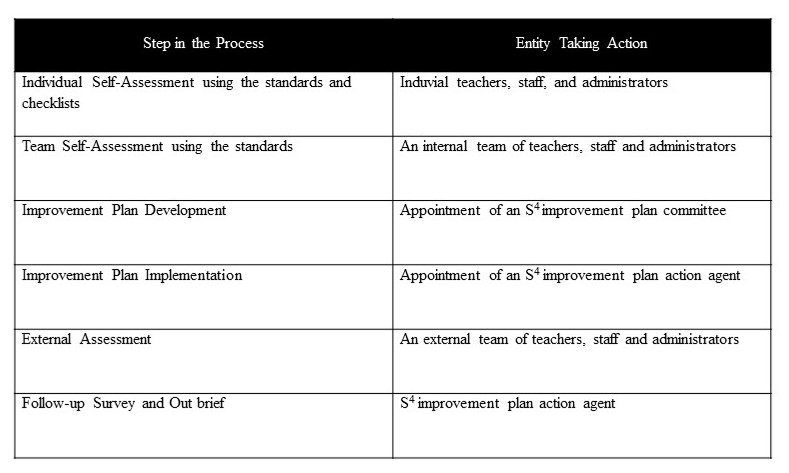6 Chapter 6 – Applying the Standards – Working the Process

As mentioned previously, the author conducted a pilot project as a proof of concept and to verify the veracity of the S4 standards and then based on the positive outcome of that study expanded the project to include a total of twelve schools including elementary, middle, and high school levels. This project sought to answer three basic research questions:
R1. Will experience with the implementation of voluntary school safety and security standards enhance the knowledge, skills, ability, and confidence of K-12 school faculty, staff, and administrators that are exposed to and use them in their schools?
R2. What impact does the conduct of a full-profile school-based emergency exercise program (active shooter, bomb threat, etc.) or a table-top simulation exercise as a focusing event have on the knowledge and confidence level of K-12 school faculty, staff, and administrators that are participants versus those who do not have that experience?
R3. What impact will the process of self-assessment and external assessment using the S4 standards have on the safety and security posture of the participating schools?
Derived from those three research questions, four hypotheses were developed for the project. Research questions one and two were measured primarily through quantitative methods. Research question number three is related to the qualitative assessment of school safety and security using the S4 standards and looked more at the collective school environment versus the impact on individual participants.
H1. School faculty, staff, and administrators who are exposed to and implement voluntary school safety and security standards will have an increased level of knowledge related to overall school safety and security and their school environment will be safer and more secure as a result.
H2. School faculty, staff, and administrators who are exposed to and implement voluntary school safety and security standards will have an increased level of confidence related to overall school safety and security and their school environment will be safer and more secure as a result.
H3. School faculty, staff, and administrators who are participants in a full profile school based emergency exercise (active shooter, bomb threat, etc.) and those that participate in a table-top simulation exercise will have a greater increase in their level of knowledge related to overall school safety and security versus those that simply experience and implement the standards.
H4. School faculty, staff, and administrators who are participants in a full profile school based emergency exercise (active shooter, bomb threat, etc.) and those that participate in a table-top simulation exercise will have a greater increase in their level of confidence related to overall school safety and security versus those that simply experience and implement the standards.
The S4 standards are designed to be used both as a self-assessment tool by individual school faculty and administrators to ensure that they are providing the best possible environment for their students in terms of safety and security and also as an external assessment measurement by school systems and districts given the lack of a universally accepted set of state or national school safety standards. Therefore, it is recommended that the self-assessment always serve as the first step and the starting point for the process. During the self-assessment process, as short comings and deficiencies are found by faculty, staff, and administration they should be documented but immediately rectified if possible, or if not possible they should be documented and an action plan should be developed to identify the resources and actions necessary to fix them with a specific due date when the action is expected to be completed.
The S4 standards were designed to be used by all types, sizes, and composition of schools and school systems and can even be used by individual teachers within their own classrooms and areas of control even if the program is not adopted school or system wide. One of the key aspects of the standards is that the do not specify “how” a school or system should be meeting the standard, but simply to specify “what” the result or outcome should be. This is important because schools come in all shapes, sizes, and resource and funding levels and as this research has shown, there is more than one way to meet a standard depending on the specific environment within a school or system. The following table shows the steps in the process and what individual or entity is involved in that step.

Table 6.1 – The S4 Standards Process
Importantly, there is no mandate to purchase a particular system or technology as is the case with some proprietary systems. While one school system may decide to purchase an electronic visitor ID and badging system, while another school can just as effectively meet that standard by using a visitor sign in log and color-coded stickers. As a result, schools have the freedom to innovate and can apply the standards in accordance with their own unique circumstances, school culture, resources, and operational environments.
Once the self-assessment is completed and any corrections made or mitigation completed on items not meeting the standards, then the next step in the process if desired would be to engage in an external assessment by an outside team using the S4 standards. The value of this step is that it provides an unbiased and honest assessment by individuals who are not necessarily invested in the outcome. Within a school system this could be accomplished by the appointment of a dedicated assessment team from across the system with expertise in each of the standard areas to conduct all of the external assessments. In some cases where this might not be feasible, simply partnering schools together were a team of faculty and staff from one school conducts the assessment on their partner and vice versa. This works very well in smaller school systems or when individual schools decide to take on the project. The external assessment should always be concluded with a frank and honest follow-up survey and out brief to inform the constituent school or system of the assessment finding and recommendations for improvement actions that should be undertaken.
Ideally, it is highly recommended that at least the self-assessment be conducted on an annual basis as part of the beginning of the school year. By incorporating this into the annual start-up routine, faculty, staff, and administration can be confident that they have identified and addressed any issues that may have resulted during the off season such as renovation or new construction of facilities. Another added benefit to completing this process is that it will also familiarize any new faculty and staff that have been hired or transferred into the new facility.
Eventually, the S4 standards could form the basis of a stand-alone school safety and security accreditation program or could be incorporated into the policies of an existing education accrediting organization or agency. However, even without that the real value is that anyone, anywhere can benefit from the S4 process and help make themselves and their school better prepared and safer.

